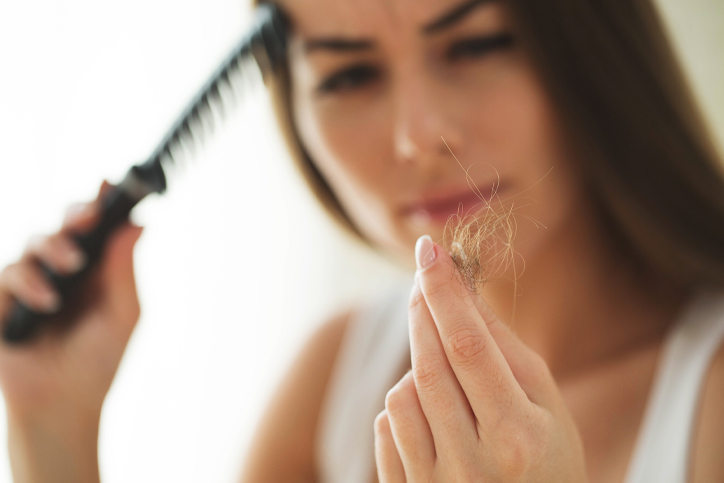Female Hair Loss
Conveniently located in Danville to serve the entire Bay Area - San Ramon, Alamo, Walnut Creek, Moraga, Lafayette, Dublin, Pleasanton, Orinda, Castro Valley, Livermore Contact UsTestimonialsFemale Hair Loss Signs and Symptoms
There are early signs of female hair loss that patients can watch out for in order to take immediate action to address the problem. The first among these is the substantial falling out of hair strands. This can be observed when combing, when passing fingers through the hair, or even when looking at one’s bed after waking up. Another sign would be the slow but gradual thinning of the amount of hair that the patient has. Follicles naturally produce fewer and fewer strands of hair due to the normal aging process. In more advanced cases of female hair loss, patients exhibit balding patches in certain areas of their scalp. These are typically a sign of more severe health issues that must be addressed right away.
Your Female Hair Loss treatment will be performed in Blackhawk Hair Restoration‘s surgery center located in Danville.
Cause of Female Hair Loss
Hair loss, or alopecia, can manifest in different ways. Pregnancy and hormonal changes may contribute to temporary hair loss. Women can lose hair a few months after giving birth. Men may observe a receding hairline as a tell-tale sign of alopecia, whereas women may notice that the part in their hair is getting wider.
Another leading cause of hair loss is heredity, which can cause pattern baldness later in life. Hair thinning or loss can also happen when you are currently undergoing chemotherapy treatment. Excessive hairstyling can also cause damage to the hair follicles, leading to baldness. Extreme stress or emotional shock can also present symptoms of hair loss.
Who is at Risk of Developing Female Hair Loss?
Female hair loss is commonly attributed to genetic factors or aging. Some women are simply genetically predisposed to have thinner hair and are more prone to producing fewer strands as they grow older.
Patients who are entering their middle-age years become more prone to hair loss, as well. This can be mitigated by a good diet and a healthy lifestyle.
Classification of Female Hair Loss
There are several different types of female hair loss:
Female pattern baldness, also referred to as androgenetic alopecia, is the most common type among women. Unlike male pattern baldness, which manifests as a receding hairline, female pattern baldness is an overall thinning of the hair. This hereditary hair loss can occur in women between the ages of 12 to 40. Hair thinning happens because you have genes that inherit the healthy growth of your hair follicles, causing them to shrink. Over time, the hair follicles no longer grow any hair.
Alopecia areata is a hair loss type that occurs as patches all over the head or body. It starts as a round patch, which can then widen and overlap with more developing patches. The symptoms are often sudden and can occur at any age across all ethnic groups. It is an autoimmune condition where the body attacks the hair follicles, leading to hair fall. Hair regrowth is unpredictable; some may recover, while others may not grow back their hair.
Cicatricial alopecia, on the other hand, causes permanent hair loss. Scar tissue develops on the hair follicle, which inhibits the growth of new hair. During the early stages of this condition, the symptoms include red and inflamed hair shafts. The hair follicles are destroyed in the deeper layers due to inflammation.
Traumatic alopecia is another type of hair loss in women and can lead to permanent loss of hair. Excessive styling and use of heat on the scalp and hair could cause the hair shaft to break or destroy the hair follicles. Hot combs, blow dryers, straightening irons, and heating caps can lead to hair loss. Strong chemicals and inappropriate hairstyling practices can also cause hair to be severely damaged.
Diagnosing Female Hair Loss
There are a few ways to discover if patients are experiencing female hair loss. A blood test can uncover any medical conditions that are causing to the loss of hair strands, the thinning of hair, or dermatological issues that are affecting follicles.
A simple method involves female patients simply gently pulling at their hair to see if they come away with a significant number of strands. A scalp biopsy can also reveal problems when follicles are examined under microscopes. Finally, light microscopy can be used to examine hair shafts to discover problems in growing new hair.
After your diagnosis, we will discuss your treatment options. A personalized treatment plan will be developed to address your hair loss.
Female Hair Loss Treatment Options
Female hair loss treatments can improve their quality of life and help them cope with social stigma. Hair plays a major role in women’s grooming and self-image. Almost half of women may suffer from hair loss at one point in their life, especially postpartum hair loss.
There are a number of treatment options available to patients who are suffering from female hair loss. Hair transplantation with ARTAS or NeoGraft can be a viable option. During these procedures, healthy follicles are harvested from certain areas of the scalp. These are then transplanted to spots where the hair is beginning to thin.
The Healing Process After a Hair Transplant
The recovery process after a hair transplant looks different for every individual and depends on the exact procedure performed. You may be able to get back to your normal routine right away. For invasive surgical procedures, you may have to rest for a few days before you can get back to work.
Find Out More Today
Contact Dr. Stephen Ronan now by calling (925)736-5757 to learn more about what treatment for female hair loss in Danville involves. Patients can schedule a consultation at Blackhawk Hair Restoration to learn about potential solutions to their hair-loss problem.
“From the moment I walked in my experience was amazing. The staff is friendly and highly knowledgeable and the work done there is unmatched! “
“I could not have been more pleased with my experience at BPS! The staff were positive and professional from the very start. They checked in on me throughout the process… “




